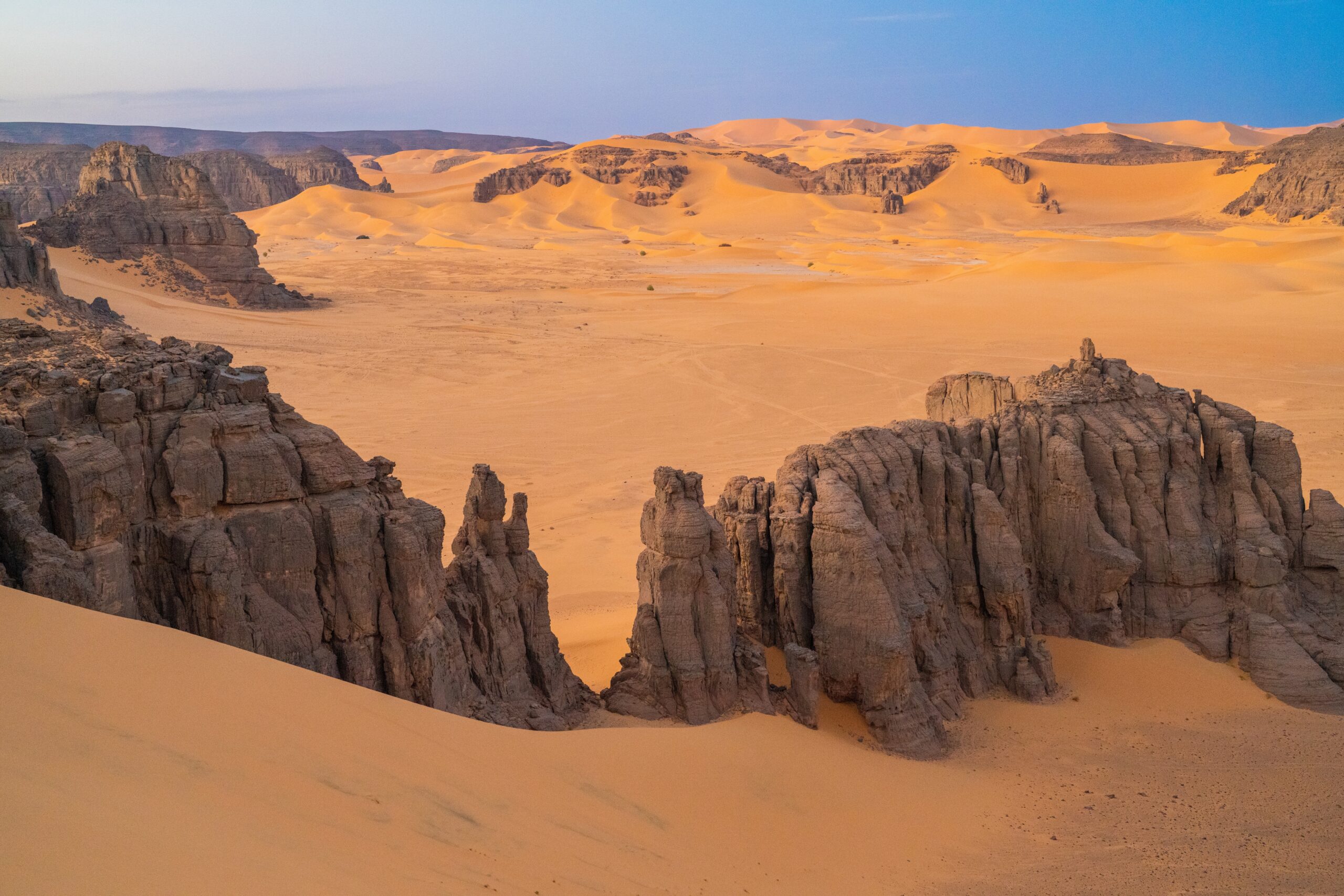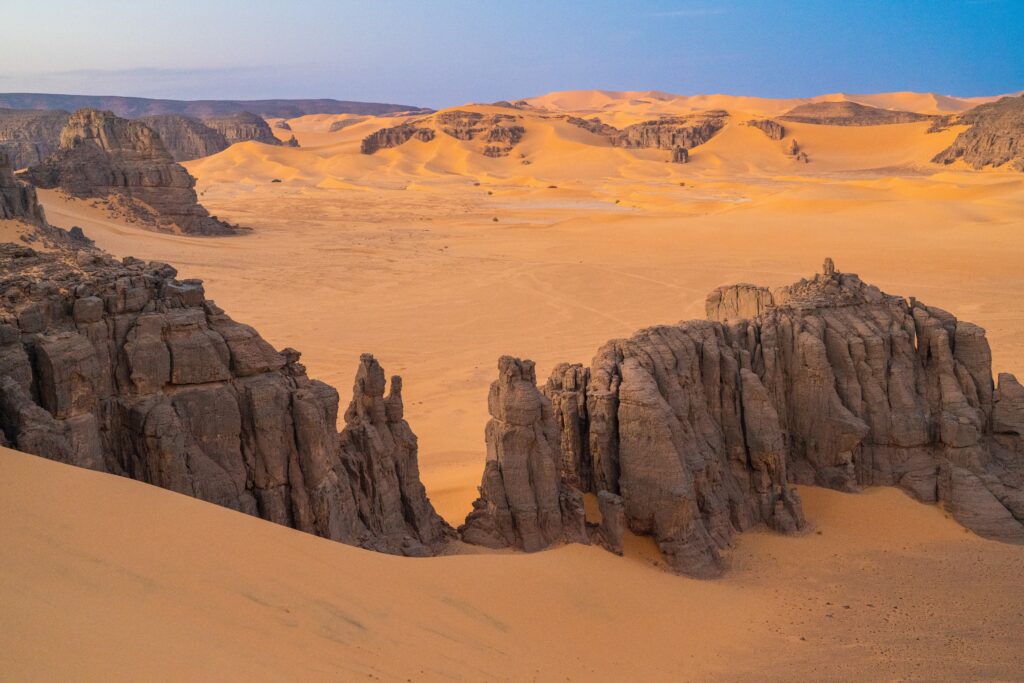When most of us think of desserts, we conjure up images of scorchingly hot, arid, and sandy landscapes, perhaps with the odd oases or two! However, the definition of a desert is simply a natural environment that lacks water, so a desert can be hot or cold but is always dry. And that’s not the only surprising truth about these seemingly barren ecosystems— this article explores the world’s largest deserts and uncovers some fascinating facts about these extreme environments and the wildlife that manage to survive there.

Antarctica Leads the Pack
The huge land mass at the southern end of our planet is entirely covered in ice and rock, a staggering 13.96 million square kilometers of it! This frozen expanse at the South Pole takes the crown as the world’s largest desert, technically classified as such because it receives incredibly low precipitation, averaging less than 200 millimeters annually.
This harsh environment is home to some unique life forms adapted to the extreme cold, like penguins and microscopic tardigrades. Because there are no large land mammals or other carnivores, penguins can breed on the inland ice fields without fear of attack by predators.
The Arctic is Number Two
The frozen landscape of the Arctic, encompassing parts of North America, Greenland, and Eurasia, follows closely behind Antarctica, with a vast 13.7 million square kilometers of icy desert.
Although it may look desolate and lifeless at first glance, the North Pole desert isn’t as barren as it seems. It boasts diverse ecosystems like tundra (seasonal grasslands) and polar ice caps, which support some unique terrestrial animals, including polar bears, caribou, and arctic foxes.
The Sahara Was Home to Ancient Humans
If we shift our focus to hot deserts, the famous Sahara in North Africa reigns supreme. This vast expanse of sand and rock covers a whopping 8.6 million square kilometers, roughly the size of the United States and Mexico combined! Although deserts are typically flat places, the Erg Chebbi dunes in Morocco are an exception to this—these sandy mountains tower over 300 meters over the surrounding landscape.
The Sahara boasts a long and fascinating history, with evidence of human settlements dating back thousands of years. Ancient rock art adorns cave walls, telling stories of hunter-gatherer societies that once thrived here thousands of years ago.
While the Sahara is well known for its harsh aridity, pockets of life persist. The Bodélé Depression, a vast basin, transforms into a temporary lake during the rainy season, attracting thousands of migratory birds in a beautiful display of life amidst the desolate sands.
Dinosaurs Once Roamed The Gobi Desert
The Gobi Desert, stretching across parts of Mongolia and China, might not be the largest, but it holds a special place in our understanding of Earth’s history. This cold desert, characterized by vast steppes and rocky outcrops, was once a lush ecosystem teeming with dinosaurs!
Fossils unearthed here, like those of Velociraptors (a small, gregarious species), have provided invaluable insights into these prehistoric giants. Nowadays, you’re more likely to find cold-climate camels, antelopes, and gazelles.
The Gobi has also been a cradle of human civilization for millennia. Nomadic herders have traveled its vast plains for centuries, their way of life organically linked to the limitations and seasonal rhythms of this harsh environment.
Not All Deserts are Sand Dunes
The Patagonian Desert in South America, spanning parts of Argentina and Chile, challenges our typical image of a desert. This large region is known for its rocky plateaus, scrublands, and even glaciers. Strong winds and cold temperatures are the norm here, although annual rainfall remains pitifully low. As a consequence, the landscape looks more like a rocky, windswept steppe than a sea of sand.
The Atacama is the Driest Place on Earth
Nestled within the Patagonian Desert itself lies the smaller Atacama Desert, an intensely arid region that holds the title of the driest place on planet Earth. Some areas here haven’t seen rain for centuries, creating a landscape almost entirely devoid of greenery and inhabited only by the hardiest of creatures.
The only large animals that survive here are llamas, alpacas, guanacos, and vicuñas, which have adapted to the high altitudes and extreme dryness. They tend to congregate near salt flats and lagoons, where some standing water is available for drinking, although it is often quite salty!
Oases Offer Life an Opportunity
Despite their arid conditions, deserts are not completely devoid of abundant life. Oases are areas with access to fresh water, providing a lifeline for plants and animals. These green havens often form around natural springs or underground water sources and provide an opportunity for life to flourish, albeit in a limited area.
The oasis of Huacachina in Peru is nestled amongst the towering sand dunes and is home to a far greater biodiversity of life than the desert that surrounds it.
There are Hidden Treasures
The Namib Desert in Africa, known for its vast sand dunes and stark, desolate beauty, holds the world’s largest diamond deposits. These precious stones were formed over millions of years by immense pressure and heat, creating a seam of valuable gems beneath the sand.
Namibia is one of the world’s top diamond producers by value, boasting some of the highest quality diamonds found anywhere. The most famous source is the Cullinan Diamond Mine in the Sperrgebiet region, where some of the largest and most valuable diamonds ever discovered originated.
The Namib Desert also boasts unique plant life adapted to the arid conditions, like the Welwitschia mirabilis, a strange and ancient plant that can survive for centuries.







